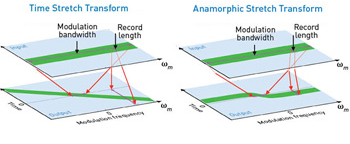
The Stretched Modulation Distribution (SM) graphically depicts the impact of a specific group delay dispersion choice on record length and modulation bandwidth, and thus is a key tool in engineering physical or digital filters to compress time-bandwidth product using AST.
In the diagrams above on the right, the length of the horizontal axis at t = 0 is the total envelope bandwidth, and the extent along the vertical direction is the total record length. The top diagram in each case is the wideband input signal; the bottom diagram is the transformed signal using a linear (left) and a nonlinear (right) group delay dispersion. While both choices dramatically reduce modulation bandwidth, only the nonlinear filter does not result in a dramatic expansion of record length, and thus can achieve TBP compression.

The diagrams below on the right show SM for a real signal in the near-field and far-field regimes, respectively. Far field is achieved for large amount of group velocity dispersion, where the signal has a very large bandwidth and satisfies the stationary phase approximation, leading to one-to-one mapping of frequency into time/space. Conversely, the near field refers to the regime before the stationary phase approximation is satisfied. In both cases, complex-field detection is used to recover the input. The warping of the time-frequency map is a key element of AST data compression.
